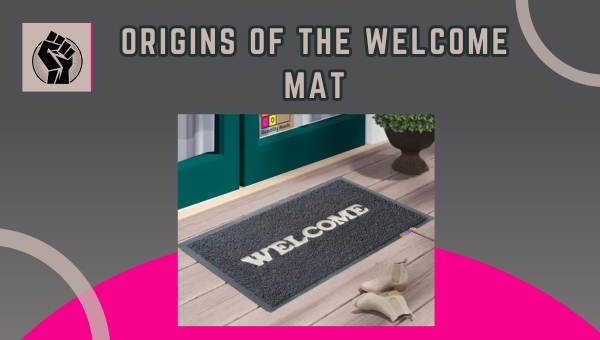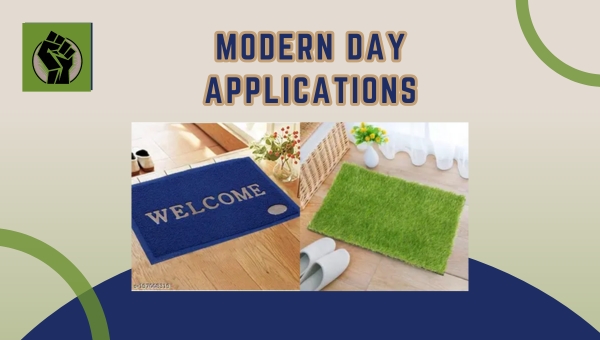Imagine stepping into a home, greeted warmly by a simple yet meaningful floor mat welcome. This humble household item has journeyed through centuries, weaving its way into various traditions and cultures.
From functional beginnings to a modern-day decorative staple, the history of floor mat welcome is as fascinating as it is enduring. Its role has evolved, yet its purpose remains universal—offering a heartfelt welcome. Dive in as we uncover the origins, cultural significance, and adaptations of this everyday essential.
Origins of the Welcome Mat
The journey of the floor mat welcome traces back through centuries of development, blending function with tradition. Across time, these mats have evolved from simple utilitarian tools to items of cultural and decorative significance.

Let’s explore the early beginnings and the role they’ve played in various cultural practices.
Early Beginnings
The origin of the welcome mat can be found in ancient societies where practicality was the primary motivator. Initially, basic mats were crafted to prevent dirt and mud from entering living spaces. In regions with harsh climates or dusty terrains, these mats served as essential tools for maintaining cleanliness.
Historians believe that the earliest forms of mats were made using natural materials readily available in local environments. For instance:
- In ancient Egypt, mats were woven from reeds harvested along the Nile River. These mats provided both cleanliness and a sense of hospitality when placed at entrances.
- In Mesopotamia, early civilizations used woven palm fibers to create mats that were functional and durable. These mats were a staple in homes and public spaces alike, reflecting the community’s resourcefulness.
- In East Asia, particularly in regions like China and Japan, rice straw was commonly used to craft mats. These were lightweight yet effective for trapping dirt, showcasing an innovative approach to household care.
As societies advanced, the use of mats transitioned beyond mere functionality. By the medieval period, welcome mats began to incorporate simple designs, indicating a shift toward aesthetics and personalization. This marked the beginning of mats becoming symbols of warmth and hospitality.
Cultural Significance
The floor mat welcome holds a unique place in many cultures, representing more than just a household item. Over time, these mats became intertwined with customs and traditions, reflecting the values and beliefs of different societies.
Here’s how they’ve played a role globally:
- Symbol of Hospitality: In many cultures, placing a welcome mat at the entrance signifies an open and inviting home. It demonstrates the host’s willingness to welcome visitors, making them feel at ease upon arrival.
- Ritual Practices:
- In Indian culture, mats are sometimes used during religious ceremonies to symbolize purity. Placing a mat at the entrance is considered auspicious, ensuring positive energy enters the home.
- In Japan, the concept of cleanliness is deeply rooted. Traditional tatami mats, though not strictly welcome mats, serve a similar function in maintaining cleanliness and respect for the living space.
- Seasonal Celebrations:
- In Western cultures, decorative welcome mats often reflect seasonal themes such as Christmas or Halloween. These mats add a festive touch while continuing to serve their primary purpose.
- In Scandinavian countries, mats are frequently adorned with winter motifs, blending functionality with cultural aesthetics.
By examining these practices, it becomes clear that the floor mat welcome is not just an everyday item but a meaningful emblem of cultural identity. Whether used to protect, decorate, or signify hospitality, these mats have played a pivotal role in shaping societal norms across centuries.
Also Read: Vitamin Water Ingredients – What You Need to Know!
Evolution Over the Centuries
The journey of the floor mat welcome has been fascinating, showcasing advancements in materials, design, and overall utility. From rudimentary beginnings to modern-day sophistication, these mats have continually evolved to meet changing needs and preferences.

Let’s explore how materials and craftsmanship, along with design trends, have transformed over the years.
Materials and Craftsmanship
Over time, the materials and techniques used to create welcome mats have undergone significant changes. Early mats were simple and functional, but advancements in craftsmanship have turned them into items of durability and beauty.
Here’s how materials and techniques have evolved:
- Natural Fibers in the Early Days: Initially, welcome mats were made from readily available natural materials such as straw, coir (coconut fibers), and reeds. These were tightly woven by hand to create a sturdy surface that could withstand dirt and debris.
- Introduction of Synthetic Materials: As technology progressed, synthetic materials like rubber and vinyl started replacing natural fibers. These materials provide enhanced durability, water resistance, and ease of cleaning, making them a popular choice for modern households.
- Focus on Craftsmanship: In earlier times, crafting a welcome mat was a labor-intensive process, often carried out by skilled artisans. With industrialization, mass production techniques emerged, allowing for uniformity and affordability.
- Eco-Friendly Innovations: In recent years, there has been a shift back toward sustainable materials, with eco-conscious buyers opting for mats made from recycled or biodegradable products, combining traditional craftsmanship with modern values.
Design Trends and Patterns
The designs and patterns of welcome mats have seen remarkable changes, reflecting the aesthetic preferences of each era. From simplistic to intricate, the visual appeal of these mats has significantly evolved.
Below is a breakdown of the changing trends:
- Minimalist Beginnings: Early welcome mats were designed with a focus on function rather than form. They featured plain, unembellished patterns that prioritized practicality.
- Victorian Elegance: During the Victorian era, intricate patterns and ornate designs became popular. Mats were crafted to complement the elaborate aesthetics of the homes they adorned.
- Mid-Century Modern Influence: In the mid-20th century, bold geometric shapes and bright colors began dominating mat designs, inspired by the minimalist yet vibrant trends of that time.
- Contemporary Customization: Today, personalized welcome mats are highly sought after. From family names to quirky quotes, these designs allow homeowners to express their personalities while still serving a functional purpose.
- Cultural Inspirations: Many modern mats incorporate patterns and motifs inspired by global cultures, showcasing a blend of tradition and contemporary design that appeals to a diverse audience.
The evolution of the floor mat welcome is a testament to its enduring relevance and adaptability. By combining functionality with artistic expression, these mats continue to serve as both practical tools and decorative accents.
Modern Day Applications
The floor mat welcome has transitioned from being a mere functional object to a versatile element in homes and businesses. Its uses today range from practical purposes to enhancing interior and exterior aesthetics. Let’s explore its modern-day utility in detail.

Functional Uses
Today, welcome mats serve a variety of practical purposes, making life easier and cleaner in both residential and commercial spaces.
Here’s how they are used:
- Dirt and Moisture Control: Welcome mats are primarily used to trap dirt, dust, and moisture from shoes, preventing them from being carried indoors. This function helps maintain a cleaner environment and reduces cleaning efforts.
- Safety Enhancement: Many mats are designed with anti-slip materials, reducing the risk of accidents caused by slippery floors, especially during bad weather conditions.
- Durability in High Traffic Areas: In businesses, welcome mats are often placed in entrances where foot traffic is heavy. They protect the flooring from wear and tear, extending its lifespan.
- Brand Representation: Custom mats featuring logos or slogans are common in commercial spaces, providing a professional touch and reinforcing brand identity.
Aesthetic Appeal
Beyond functionality, welcome mats have become a key element of home decor, adding a personalized and stylish touch to entryways.
Here’s how they contribute:
- Personalized Designs: Homeowners can now choose mats with unique prints, patterns, and personalized text, reflecting their personality and welcoming guests warmly.
- Color Coordination: Available in a wide range of colors, welcome mats can complement the overall color scheme of an entryway or porch.
- Seasonal Themes: Seasonal designs, such as festive patterns during holidays, add a cheerful vibe to the entrance and make it more inviting.
- Layering Decor Trend: Combining a welcome mat with a larger decorative rug beneath has become a popular trend, creating a layered and textured look for enhanced visual appeal.
The floor mat welcome continues to evolve in both utility and design, ensuring it remains a staple in modern living. It’s a small yet impactful element that blends practicality with style seamlessly.
Also Read: History of Tonic Water: A Fascinating Journey
Cultural Variations
The concept of the floor mat welcome has subtly adapted and transformed across various cultures, reflecting unique regional practices and beliefs. Let’s delve into how different parts of the world have personalized this humble household item.
Regional Differences
Welcome mats exhibit notable variations across regions, shaped by climate, materials, and cultural aesthetics.
Here’s how they differ:
- Asia: In many Asian countries, welcome mats often feature vibrant colors and intricate patterns. For instance, in Japan, mats are minimalist, often designed with natural fibers like bamboo or straw, emphasizing simplicity and functionality.
- Europe: European welcome mats tend to be more ornate. In countries like France and Italy, mats may include family crests or floral designs, representing tradition and attention to detail.
- North America: In the United States and Canada, welcome mats are frequently humorous or personalized, featuring witty quotes or family names, blending practicality with self-expression.
- Africa: African welcome mats are often handmade, and woven from local materials such as sisal or palm leaves. These mats may include bold geometric patterns and serve as a testament to the region’s rich artisanal heritage.
- Australia: Welcome mats here often reflect the outdoor lifestyle, crafted from durable materials like rubber or coir, with motifs of native flora and fauna, resonating with the country’s natural beauty.
Symbolism and Traditions
Welcome mats hold profound symbolic meanings and are tied to various traditional practices.
Here’s a glimpse into their deeper significance:
- Hospitality: In many cultures, a welcome mat is a symbol of hospitality, an invitation for guests to feel at ease upon arrival.
- Spiritual Beliefs: In Indian households, mats are sometimes adorned with religious symbols, believed to ward off negative energies and bless those who enter.
- Seasonal Practices: In Western countries, welcome mats change with the seasons, featuring festive motifs during holidays like Christmas or Easter, blending decor with tradition.
- Rituals of Purity: In some Middle Eastern and Asian cultures, the act of wiping one’s feet on a mat before entering symbolizes purification, ensuring the home remains a sacred space.
- Community Connection: Among indigenous communities, mats can symbolize a connection to nature, often crafted from locally sourced materials, emphasizing sustainability and respect for the environment.
Cultural variations in the floor mat welcome continue to evolve, reflecting societal values and local traditions, making this simple item a fascinating cultural artifact.
The Welcome Mat in Popular Culture
The humble welcome mat has made its mark far beyond the threshold of homes and businesses. It has found a place in popular culture, symbolizing hospitality, humor, or even deeper meanings in various forms of media.
Let’s explore how welcome mats have been portrayed in entertainment and the stories behind some famous ones.
Representations in Media
Welcome mats have frequently appeared in films, television shows, and even advertisements, often serving as a subtle prop to convey a message or set the tone.
Here are some notable examples:
- Movies: In many comedy and family films, welcome mats are used to introduce a home’s vibe. For instance, a quirky mat with a funny message can hint at the personality of the characters before viewers even meet them. Some horror movies have also flipped this symbol of hospitality on its head, using it to create irony or suspense.
- Television: Sitcoms and dramas often include welcome mats as part of their set design. A personalized or unique mat can indicate a character’s personality or even their socioeconomic status. For example, in some shows, a plain, worn-out mat might suggest simplicity or financial struggles, while an elaborate one can reflect affluence.
- Advertisements: Welcome mats are frequently featured in commercials for home improvement or cleaning products. They are often used as a metaphor for inviting change, innovation, or cleanliness into one’s life.
From subtle background props to intentional storytelling elements, welcome mats have proven to be effective tools for visual storytelling in media.
Famous Welcome Mats
Over the years, certain welcome mats have gained recognition for their association with iconic stories, characters, or events.
Let’s take a deep dive into some of these renowned examples:
- The Home Alone Welcome Mat: In the classic movie Home Alone, the McCallister family’s welcome mat subtly symbolizes the warmth and chaos of their home. While the mat itself may not have taken a central role, its presence contributed to the cozy, lived-in feel of the household.
- The “Come Back With Tacos” Mat: This humorous mat became a viral sensation on social media, representing a blend of modern humor and practicality. While not tied to a specific movie or show, its popularity demonstrates how welcome mats can transcend their functional role to become cultural phenomena.
- The Hogwarts Welcome Mat: Fans of the Harry Potter series have embraced themed merchandise, including mats adorned with sayings like “Welcome to Hogwarts” or “Muggle-Free Zone.” These mats have become collectibles, connecting fans with the magical world they adore.
- The “Friends” Apartment Mat: Although the iconic purple door in the TV show Friends gets most of the attention, the mat outside Monica’s apartment has also become an item of interest for die-hard fans. Its simple design complements the nostalgic charm of the show, making it a subtle yet significant piece.
The stories behind these welcome mats show how an everyday object can gain cultural significance, becoming a symbol of humor, nostalgia, or fandom.
FAQs
What is the history of the floor mat welcome?
The history of the floor mat welcome dates back centuries, originating as simple tools for cleaning footwear before entering homes. Over time, they evolved into symbols of hospitality and cultural expression.
Why are welcome mats significant in different cultures?
Welcome mats often symbolize hospitality and warmth. In some cultures, they also reflect traditions, beliefs, or even social status, making them culturally meaningful.
What symbolic meanings are associated with welcome mats?
Welcome mats often symbolize hospitality, warmth, and inclusivity. In some traditions, they hold deeper meanings related to luck, protection, or blessings.
Are welcome mats featured in popular culture?
Yes, welcome mats often appear in films and TV shows as small but meaningful props to set scenes or convey themes of hospitality and home.
Conclusion
The history of the floor mat welcome is a fascinating journey that reflects both cultural traditions and practical needs. From its early beginnings to its modern applications, the welcome mat has evolved in materials, design, and symbolism over centuries.
It stands as a testament to human creativity and the universal desire to create a welcoming environment. Whether functional or aesthetic, this simple item carries a deeper meaning, bridging cultures and eras.
If you found this exploration insightful, there’s more to uncover. Dive into our other blogs to learn about the stories behind everyday objects and their significance in our lives!





